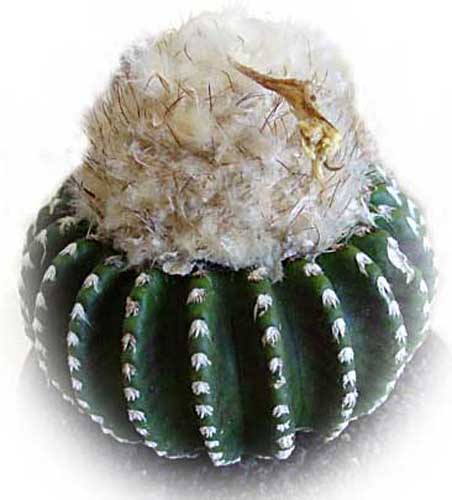
Growth Habits: Solitary globose cactus, up to 3 inches in diameter (8 cm); up to 20 prominent ribs; 8 to 10 light coloured spines in a comb like arrangement, 0.2 inch long (5 mm). They are curved back towards the body. This plant is almost always solitary with a globular body that can be up to 3in. (8cm.) in diameter. The ribs are very prominent which is a feature of the plant and can number up to about 20. The body of the plant is at first green, later turning to a reddish brown.
Scientific name: Discocactus horstii
Common names: None known.
Synonym: None known
Etymology: The cactus was named after the well known Brazilian collector Leopoldo Horst, and his wife Melita. They discovered the plant in the late sixties, so it is a relatively recent introduction to the hobby.
Origin: Brazil (Minas Gerais)
Light: It will take full sun, but prefers a little shade in the afternoon
Compost: Must be very open indeed. 50% compost to 50% gravel, perlite or pumice
Water: Water with extreme care.
Flower: The flowers are white with yellow stamens and sepals and they have a slight but distinctive perfume. They appear from the cephalous and have a covering of wool and bristles
Fruit: The colour of the fruit is white.
Cultivation: This is probably one of the most difficult cacti to keep growing on its own roots and is almost always seen as a grafted plant. If growing on its own roots is attempted the compost must be extremely free draining and watering should only take place after the compost has dried out and then only on sunny and warm days.
Habitat: The plant grows to the North-west of Grao Mogol in the Serra do Barrao in Minas Gerais, Brazil at an altitude of about 1000m. The soil consists of quartzite-sand and gravel, hence the need in cultivation for excellent drainage.
Comments: This little beauty is much sought after and is one of the most distinctive cacti you are ever likely to see. Everyone interested in cacti can pick this one out at the drop of a hat. There is just no other cactus like it. The body colour is extremely distinctive and the spines always remind me of the braid on a military uniform, I don’t know why. It does not grow very large and people who normally do not like grafted cacti (myself included) will make an exception in this case as it is by far the safest method of keeping this gem.










